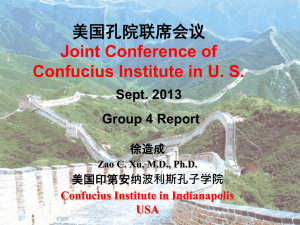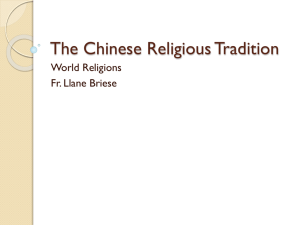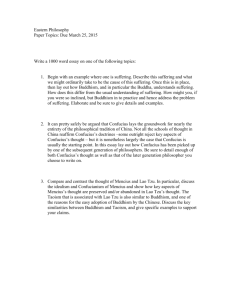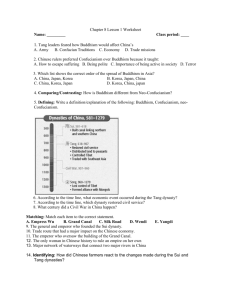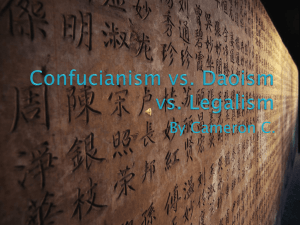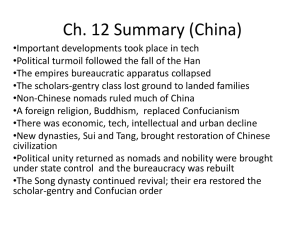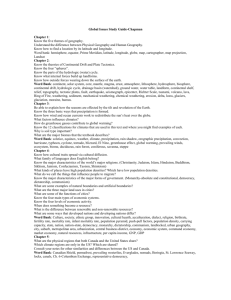religion in general
advertisement
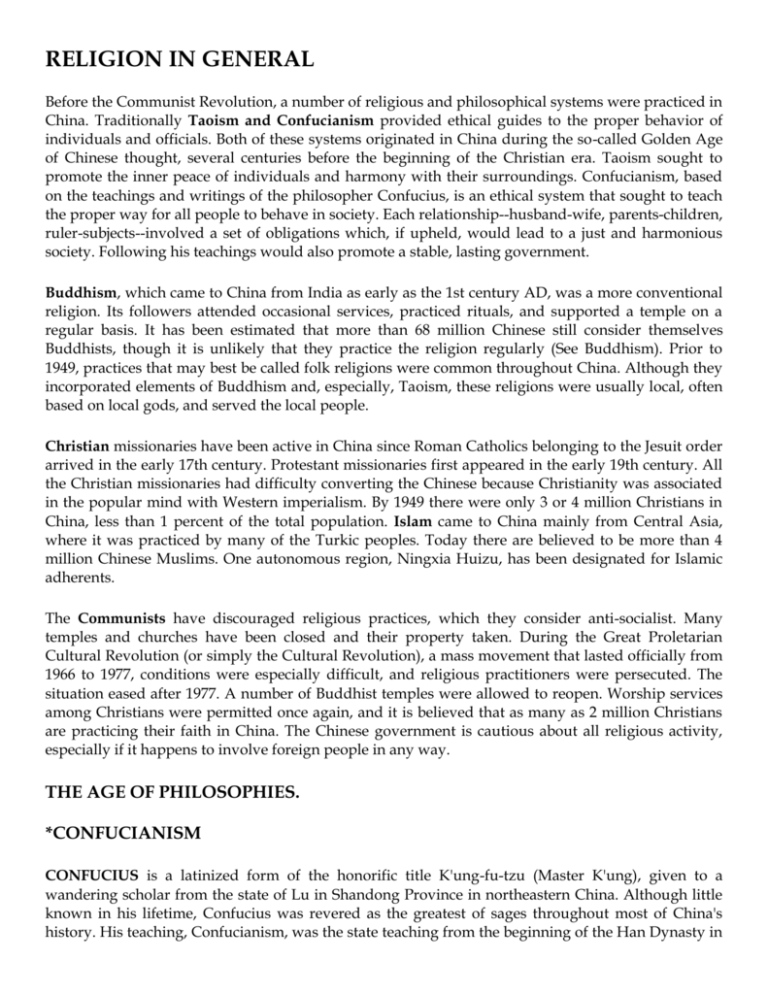
RELIGION IN GENERAL Before the Communist Revolution, a number of religious and philosophical systems were practiced in China. Traditionally Taoism and Confucianism provided ethical guides to the proper behavior of individuals and officials. Both of these systems originated in China during the so-called Golden Age of Chinese thought, several centuries before the beginning of the Christian era. Taoism sought to promote the inner peace of individuals and harmony with their surroundings. Confucianism, based on the teachings and writings of the philosopher Confucius, is an ethical system that sought to teach the proper way for all people to behave in society. Each relationship--husband-wife, parents-children, ruler-subjects--involved a set of obligations which, if upheld, would lead to a just and harmonious society. Following his teachings would also promote a stable, lasting government. Buddhism, which came to China from India as early as the 1st century AD, was a more conventional religion. Its followers attended occasional services, practiced rituals, and supported a temple on a regular basis. It has been estimated that more than 68 million Chinese still consider themselves Buddhists, though it is unlikely that they practice the religion regularly (See Buddhism). Prior to 1949, practices that may best be called folk religions were common throughout China. Although they incorporated elements of Buddhism and, especially, Taoism, these religions were usually local, often based on local gods, and served the local people. Christian missionaries have been active in China since Roman Catholics belonging to the Jesuit order arrived in the early 17th century. Protestant missionaries first appeared in the early 19th century. All the Christian missionaries had difficulty converting the Chinese because Christianity was associated in the popular mind with Western imperialism. By 1949 there were only 3 or 4 million Christians in China, less than 1 percent of the total population. Islam came to China mainly from Central Asia, where it was practiced by many of the Turkic peoples. Today there are believed to be more than 4 million Chinese Muslims. One autonomous region, Ningxia Huizu, has been designated for Islamic adherents. The Communists have discouraged religious practices, which they consider anti-socialist. Many temples and churches have been closed and their property taken. During the Great Proletarian Cultural Revolution (or simply the Cultural Revolution), a mass movement that lasted officially from 1966 to 1977, conditions were especially difficult, and religious practitioners were persecuted. The situation eased after 1977. A number of Buddhist temples were allowed to reopen. Worship services among Christians were permitted once again, and it is believed that as many as 2 million Christians are practicing their faith in China. The Chinese government is cautious about all religious activity, especially if it happens to involve foreign people in any way. THE AGE OF PHILOSOPHIES. *CONFUCIANISM CONFUCIUS is a latinized form of the honorific title K'ung-fu-tzu (Master K'ung), given to a wandering scholar from the state of Lu in Shandong Province in northeastern China. Although little known in his lifetime, Confucius was revered as the greatest of sages throughout most of China's history. His teaching, Confucianism, was the state teaching from the beginning of the Han Dynasty in 202 BC to the end of the imperial period in 1911. Disturbed by constant warfare among the states, Confucius taught that most of the ills of society happened because people forgot their stations in life and rulers lost virtue. He advocated a return to the golden antiquity of the emperors Yao and Shun, when rulers were virtuous and people knew their places. Therefore, Confucius' primary concern lay in social relations, proper conduct, and social harmony. Confucius defined five cardinal relationships: between ruler and ruled, between husband and wife, between parents and children, between older and younger brothers, and between friends. Except for the last case, all of the defined relationships are between superiors and inferiors. He emphasized the complete obedience and loyalty of the inferior to the superior but also mentioned the benevolence of the superior to the inferior. The ideal Confucian family was an extended one of three or four generations, in which authority rested with the elderly male members. Filial piety (obedience to parents) was one of the most important virtues emphasized by later Confucians. Confucius reportedly spent his last years editing and completing some of the books that came to be known as Five Classics. These include the `Classic of Poetry', `Classic of History', `Spring and Autumn Annals', `Record of Rites', and `Classic of Changes', or `I Ching'. Memorized by scholars for generations in China, these books and four other works, including the `Analects', a compilation of Confucian teachings, were the subjects of civil service examinations for over 2,000 years. (See Confucius) Confucianism commanded a greater following some 200 years later, during the time of Mencius, or Meng-tzu (371-289 BC). He was second only to Confucius himself in shaping Confucianism. His three main tenets were the basic good nature of human beings, the notion of society with a distinct distribution of functions, and the ruler's obligation to the people. On the last point, Mencius elaborated on the concept of the mandate of heaven, which allows that rulers lose support of heaven when they cease to be virtuous. The concept served as the basis of revolts in China and the succession of new rulers. MENICIUS MENG-TZU The `Meng-tzu', meaning "Master Meng," was written by the philosopher Mencius (a Latinized form of the name Meng-tzu) in the 4th century BC. The work earned for its author the title of "second sage" in China. The book deals with government and asserts that the welfare of the people comes before all else. When a king no longer is good to the people, he should be removed--by revolution if necessary. Mencius, like Confucius, declared that filial piety was the foundation of society. One unusual doctrine that Mencius supported was that of the natural goodness of mankind, for which he found proof in the natural love children have for their parents. Two other philosophies that have had an enduring influence on Chinese thought are Taoism and Legalism. Taoism gave the Chinese an alternative to Confucianism--passivity and escape to nature-while Legalism provided the Chinese state with one of its basic doctrines. *TAOISM In the Chinese language the word tao means "way," indicating a way of thought or life. There have been several such ways in China's long history, including Confucianism and Buddhism. In about the 6th century BC, under the influence of ideas credited to a man named Lao-tzu, Taoism became "the way". like Confucianism, it has influenced every aspect of Chinese culture. Taoism began as a complex system of philosophical thought that could be indulged in by only a few individuals. In later centuries it emerged, perhaps under the influence of Buddhism, as a communal religion. It later evolved as a popular folk religion. Philosophical Taoism speaks of a permanent Tao in the way that some Western religions speak of God. The Tao is considered unnamed and unknowable, the essential unifying element of all that is. Everything is basically one despite the appearance of differences. Because all is one, matters of good and evil and of true or false, as well as differing opinions, can only arise when people lose sight of the oneness and think that their private beliefs are absolutely true. This can be likened to a person looking out a small window and thinking he sees the whole world, when all he sees is one small portion of it. Because all is one, life and death merge into each other as do the seasons of the year. They are not in opposition to one another but are only two aspects of a single reality. The life of the individual comes from the one and goes back into it. The goal of life for a Taoist is to cultivate a mystical relationship to the Tao. Adherents therefore avoid dispersing their energies through the pursuit of wealth, power, or knowledge. By shunning every earthly distraction, the Taoist is able to concentrate on life itself. The longer the adherent's life, the more saintly the person is presumed to have become. Eventually the hope is to become immortal. LAO-TZU (604?-531? BC). Some people believe that only one man, Lao-tzu, wrote the most translated work in all the literature of China, the `Lao-Tzu' (also called `Tao-te Ching'). The book is the earliest document in the history of Taoism ("the Way"), one of the major philosophical-religious traditions that, along with Confucianism, has shaped Chinese life and thought for more than 2,000 years. It is a viewpoint that emphasizes individuality, freedom, simplicity, mysticism, and naturalness. (See Confucius) Knowledge of Lao-tzu is so scarce that only legends remain. His earliest biographer, who wrote in about 100 BC, relates that Lao-tzu lived in the district of Hu in present-day Henan Province during the Chou Dynasty (1122-221 BC). Presumably he worked in astrology and divination at the court of the emperor. The biographer tells of a meeting of Lao-tzu with the younger Confucius, which would mean Lao-tzu lived in about 500 BC. Another story says that he left China during the decline of the Chou Dynasty, and on his way west wrote the `Tao-te Ching', after which he disappeared. He was worshipped as an Imperial ancestor during the T'ang Dynasty (618-907). Scholars today believe that the book cannot have been written by one man. Some of the sayings in it may date from the time of Confucius, while others are from a later period. It is possible that the name Lao-tzu represents a type of scholar and wise man, rather than one individual. `Tao-te Ching' The `Tao-te Ching', meaning "Classic of the Way of Power," is one of the great works of ancient China not included among the Confucian Classics. The presumed author, Lao-tzu, is considered to be the founder of Taoism. He may have been alive at the same time as Confucius but older. The book is not only significant philosophically, but it is also one of the most sacred scriptures of the Taoist religion. (See Lao-tzu) CHUANG-TZU (4th century BC), Chinese philosopher, author, and teacher; classic work bears his name; influential in development of Chinese philosophy and religious thought; interpreted Taoism (from tao, "way") differently from Lao-tzu; Chuang-tzu taught that wise people accept the ebb and flow of life without attempting to challenge it; true enlightenment involves freeing oneself of traditions and personal goals that stand in the way of the mysterious, all-encompassing Tao. Communal religious Taoism is quite distinct from its philosophical counterpart. It emphasizes moral teachings and collective ceremonies. Good moral conduct is rewarded with health and long life, while bad conduct results in disease, death, and suffering in the afterlife. There is an array of gods who are administrators of the universe, of which they are a part. From these gods come revelations of sacred texts. There is an order of married priests who live in the communities they serve and perform exorcisms and complex rituals. Folk religion Taoism is part of the everyday lives of the people. The gods are intimately connected with each individual's life as bringers of calamities or givers of bountiful gifts. Each object of daily life has its presiding spirit that must be consulted and appeased. All types of Taoism have in common the quest for a harmonious, well-ordered universe. They emphasize the individual's and the group's need for unity through mysticism, magic, and ceremony. *LEGALISM *BUDDHISM Although Buddhism first entered China from India during the Later Han, in the time of Han Ming Ti (AD 58-76), it did not become popular until the end of the 3rd century. The prevailing disorders, aggravated by barbarian invasions and the flight of northern Chinese to the south, heightened the attraction of Buddhism with its promise of personal salvation, despite its lack of affinity with the society-oriented thought of the Chinese. Buddhism was founded by Siddhartha Gautama, the Buddha, a prince of the Sakya kingdom on the borders of what are now India and Nepal and a contemporary of Confucius. Intent on finding relief for human suffering, he received a moment of enlightenment while meditating under a Bo tree. The Buddha taught that desires are the source of pain, and that by overcoming desires, pain can be eliminated. To this end, he advocated meditation and pursuing the Eightfold Path, similar to the Ten Commandments of Judaism and Christianity. The objective was to reach Nirvana, the condition of serenity of spirit, where all cravings, strife, and pain have been overcome, giving way to a merging of the spirit with eternal harmony. At an early stage of its development, Buddhism split into two major trends, Mahayana (Greater Vehicle) and Hinayana (Lesser Vehicle). Hinayana remained closer to the original Buddhism and is still the religion of the Southeast Asian countries. The Buddhism of China, Korea, Japan, Nepal, Tibet, and Vietnam, however, stems largely from Mahayana. Mahayana Buddhism contained more popular elements, such as belief in repetitive prayers, heaven and deities--bodhisattvas--who would help people gain salvation. It also readily adapted to the land and people it converted. In China, it split into several schools, including Ch'an (Zen in Japan), T'ien-t'ai (Tendai in Japan), and Pure Land. Ch'an [or Zen] Buddhism Through his popular book `The Way of Zen' (1957), the British-born American philosopher Alan Watts introduced Americans to the Zen school of Buddhism, which has a long tradition of development in China and Japan. Zen (Ch'an in Chinese) is a Japanese term meaning "meditation." It is a major school of Japanese Buddhism that claims to transmit the spirit of Buddhism, or the total enlightenment as achieved by the founder of the religion, the Buddha (See Buddha; Buddhism). Zen has its basis in the conviction that the world and its components are not many things. They are, rather, one reality. The one is part of a larger wholeness to which some people assign the name of God. Reason, by analyzing the diversity of the world, obscures this oneness. It can be apprehended by the nonrational part of the mind--the intuition. Enlightenment about the nature of reality comes not by rational examination but through meditation. Meditation has been an integral part of Buddhism from the beginning. Nevertheless, a school of meditation grew up in India and was taken to China by Bodhidharma about AD 520. When the meditation school arrived in China, it had a strong foundation on which to build: Taoism, the ancient Chinese religion (See Taoism). This religion is based on the idea that there is one underlying reality called the Tao. Taoists, like the followers of the meditation school, exalted intuition over reason. This Taoist tradition was easily absorbed by the Chinese meditation school, the Ch'an. Within two centuries the meditation school had divided into two factions: Northern Ch'an and Southern Ch'an. The northern school, a short-lived affair, insisted on a doctrine of gradual enlightenment. The southern school, which became dominant, held to a doctrine of instantaneous enlightenment. The southern school evolved under the powerful influence of Hui-neng (638-713), who is recognized as the sixth great patriarch of Zen and the founder of its modern interpretation. In a sermon recorded as the "Platform Scripture of the Sixth Patriarch," he taught that all people possess the Buddha nature and that one's nature (before and after being born) is originally pure. Instead of undertaking a variety of religious obligations to seek salvation, one should discover one's own nature. The traditional way to do this, sitting in meditation, is useless. If one perceives one's own nature, enlightenment will follow suddenly. The goal of adherents of the southern Ch'an is to gain transcendental, or highest, wisdom from the depths of one's unconscious, where it lies dormant. Ch'an tries to attain enlightenment without the aid of common religious observances: study, scriptures, ceremonies, or good deeds. Reaching the highest wisdom comes as a breakthrough in everyday logical thought. Followers are urged to find within themselves the answer to any question raised within because the answer is believed to be found where the question originates. Training in the methods of meditation leading to such an enlightenment is best transmitted from master to disciple. Ch'an flourished in China during the T'ang and Sung dynasties (960-1279), and its influences were strongly felt in literature and painting. Ch'an declined during the Ming era (1141-1215), when Ch'an masters took up the practice of trying to harmonize meditation with the study of traditional scriptures. Meanwhile, sects of Zen had been transplanted to Japan. The Rinzai school was taken there in 1191 by the priest Enzai (1141-1215), and the Soto tradition arrived in 1227, taken there by Dogen (1200-53), the most revered figure in Japanese Zen. These schools had their origin in China during the 9th century, when Ch'an divided into five sects that differed from each other in minor ways. The Rinzai sect evolved from the work of Lin-chi (died 866), who was an exponent of sudden enlightenment. The Soto was founded by Liang-chieh (died 869) and Pen-chi (died 901). The Soto stressed quiet sitting in meditation to await enlightenment. A third group, the Obaku, was established in 1654. The Obaku school is closer to the Rinzai tradition except for its emphasis on invoking the name of Buddha. Zen gained an enthusiastic following among the Samurai warrior class and became in effect the state religion in the 14th and 15th centuries. In the 16th century Zen priests were diplomats and administrators, and they enhanced cultural life as well. Under their influence literature, art, the cult of the tea ceremony, and the No drama developed. The focal point of Zen is the monastery, where masters and pupils interact in the search for enlightenment. A newcomer arrives at a monastery with a certificate showing that he is a regularly ordained disciple of a priest. He is at first refused entry. Finally being admitted, he spends a few days of probation being interviewed by his master. When he is accepted he is initiated into the community life of humility, labor, service, prayer and gratitude, and meditation.
